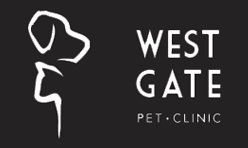Bloat – a more technical term is gastric dilatation-volvulus (GDV) – is a lifethreatening condition that requires immediate medical and surgical intervention. Westgate Pet Clinic offers a minimally invasive surgery called laparoscopic assisted prophylactic gastropexy (LAPG) that is highly effective in preventing GDV.
First, some basics:
1) Bloat – or GDV –is caused when the stomach becomes filled with gas, liquid and food. The exact mechanism is not fully understood, but occasionally this combination greatly distends the stomach and causes rotation on its axis – hence cutting off blood supply to the stomach. In addition, gas and ingesta are entrapped – further distending the stomach with gas. This condition is extremely painful for the affected patient. The lack of blood flow allows toxins to accumulate in stagnate gastric blood – upon surgical correction, this unleashes a plethora of toxins that can cause organ failure including significant cardiac arrhythmias.
2) Treatment is aimed at decompression (evacuating the stomach contents – hence relieving pain) and then surgical de-rotation of the stomach followed by anchoring the stomach to the body wall to prevent GDV from occurring again.
3) Post operative complications are frequent – up to 80% in some studies – and is a period of high mortality. These complications are often a result of the toxemia noted above.
4) Any dog can have a GDV, but in general deep chested breeds are prone. Breeds most susceptible include Great Dane, St. Bernard, Weimaraner, Standard Poodle and setter breeds. Oddly enough, one study noted Basset Hounds having increased risk despite their smaller size. But remember, ANY dog can have a GDV.
5) Clinical signs of GDV include Large, hard distended abdomen, retching with little production of vomitus and marked discomfort of the patient. If these signs are observed – get your pet to the veterinarian IMMEDIATELY.
What Can Be Done to Prevent GDV?
The stomach can be anchored to the body wall hence preventing it from rotating on its axis. This is called a prophylactic gastropexy. There are several techniques described – I’ll briefly explain the laparoscopic assisted prophylactic gastropexy (LAPG) that we employ at Westgate Pet Clinic.
The advantage of LAPG over an open prophylactic gastropexy is reduced invasiveness of the procedure, less pain and quicker recovery time from surgery.
When performed, LAPG is typically done at the time of spay or castration – but can be done any time prior to an actual GDV event.
For a LAPG, your pet is anesthetized and positioned on their back and the belly is prepared for sterile surgery. Two small incisions are made into the abdomen that allows us to introduce the laparoscope (the camera that allows us to visualize internally) in one and the cannula for instrumentation in the other.
The stomach wall is grasped with special forceps and retracted to the hole where the instrument cannula is. This small hole is then enlarged to allow visualization of the stomach and an incision is made into the outer surface of the stomach. This stomach incision is then closed along with the abdominal wall incision. In this way – the gastric wall heals up being attached to the body wall – this attachment is what prevents the stomach from rotating.
View of the stomach attached to the body wall:
Preventative gastropexy, regardless of technique, is a highly successful procedure in preventing GDV and Westgate Pet Clinic recommends all highrisk breeds have one performed at time of neutering. The LAPG described is a minimally invasive technique that can be done and we’re proud to perform at Westgate Pet Clinic.
What's Next
Call us or schedule an appointment online.
Meet with a doctor for an initial exam.
Put a plan together for your pet.


